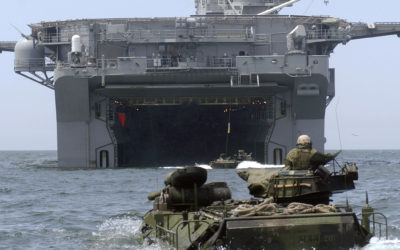On April 26, U.S. President Joe Biden welcomed South Korean President Yoon Suk-yeol to the White House for a summit meeting to celebrate the seventieth anniversary of the U.S.-South Korea alliance and open a new chapter for the next seventy years of expanded cooperation. Amid a substantial list of topics discussed by the two leaders, extended deterrence emerged as the top deliverable.
Chinese Spy Balloon Over the U.S.: An Aerospace Expert Explains How the Balloons Work and What They Can See
Chinese Spy Balloon Over the U.S.: An Aerospace Expert Explains How the Balloons Work and What They Can See
Chinese Spy Balloon Over the U.S.: An Aerospace Expert Explains How the Balloons Work and What They Can See
The U.S. military shot down what U.S. officials called a Chinese surveillance balloon off the coast of South Carolina on Feb. 4, 2023. Officials said that the U.S. Navy planned to recover the debris, which is in shallow water.
The U.S. and Canada tracked the balloon as it crossed the Aleutian Islands, passed over Western Canada and entered U.S. airspace over Idaho. Officials of the U.S. Department of Defense confirmed on Feb. 2, 2023, that the military was tracking the balloon as it flew over the continental U.S. at an altitude of about 60,000 feet, including over Malmstrom Air Force Base in Montana. The base houses the 341st Missile Wing, which operates nuclear intercontinental ballistic missiles.
The next day, Chinese officials acknowledged that the balloon was theirs but denied it was intended for spying or meant to enter U.S. airspace. U.S. Secretary of State Antony Blinken said that the balloon’s incursion led him to cancel his trip to Beijing. He had been scheduled to meet with Chinese Foreign Minister Qin Gang on Feb. 5 and 6.
The Pentagon has reported that a second suspected Chinese balloon was seen over Latin America. On Feb. 4, officials told reporters that a third Chinese surveillance balloon was operating somewhere else in the world, and that the balloons are part of a Chinese military surveillance program.
Monitoring an adversary from a balloon dates back to 1794, when the French used a hot air balloon to track Austrian and Dutch troops in the Battle of Fleurus. We asked aerospace engineer Iain Boyd of the University of Colorado Boulder to explain how spy balloons work and why anyone would use one in the 21st century.
What is a spy balloon?
A spy balloon is literally a gas-filled balloon that is flying quite high in the sky, more or less where we fly commercial airplanes. It has some sophisticated cameras and imaging technology on it, and it’s pointing all of those instruments down at the ground. It’s collecting information through photography and other imaging of whatever is going on down on the ground below it.
Why would someone want to use a spy balloon instead of just using spy satellites?
Satellites are the preferred method of spying from overhead. Spy satellites are above us today, typically at one of two different types of orbit.
The first is called low Earth orbit, and, as the name suggests, those satellites are relatively close to the ground. But they’re still several hundred miles above us. For imaging and taking photographs, the closer you are to something, the more clearly you can see it, and this applies to spying as well. The satellites that are in low Earth orbit have the advantage that they’re closer to the Earth so they’re able to see things more clearly than satellites that are farther away.
The disadvantage these low Earth orbit satellites have is that they are continually moving around the Earth. It takes them about 90 minutes to do one orbit around the Earth. That turns out to be pretty fast in terms of taking clear photographs of what’s going on below.
The second type of satellite orbit is called geosynchronous orbit, and that’s much farther away. It has the disadvantage that it’s harder to see things clearly when you’re very, very far away. But they have the advantage of what we call persistence, allowing satellites to capture images continuously. In those orbits, you’re essentially overlooking the exact same piece of ground on the Earth’s surface all the time because the satellite moves in exactly the same way the earth rotates – it rotates at the exact same speed.

A U.S. satellite photo showing a Soviet submarine in port in 1982. National Reconnaissance Office
A balloon in some ways gets the best of those. These balloons are much, much closer to the ground than any of the satellites, so they can see even more clearly. And then, of course, balloons are moving, but they’re moving relatively slowly, so they also have a degree of persistence. However, spying is not usually done these days with balloons because they are a relatively easy target and are not completely controllable.
What types of surveillance are spy balloons capable of?
I don’t know what’s on this particular spy balloon, but it’s likely to be different kinds of cameras collecting different types of information.
These days, imaging is conducted across different regions of the electromagnetic spectrum. Humans see in a certain range of this spectrum, the visible spectrum. And so if you have a camera and you take a photograph of your dog, that’s a visible photograph. That’s one of the things spy aircraft do. They take regular photographs, although they have very good zoom capabilities to be able to magnify what they’re seeing quite a lot.
But you can also gather different kinds of information in other parts of the electromagnetic spectrum. Another fairly well-known one is infrared. If it’s nighttime, a camera operating in the visible part of the spectrum is not going to show you anything. It’s all going to be dark. But an infrared camera can pick up things from heat in the dark.
How do these balloons navigate?
Most of these balloons literally go where the wind blows. There can be a little bit of navigation, but there are certainly not people aboard them. They are at the mercy of whatever the weather is. They sometimes have guiding apparatus on them that change a balloon’s altitude to catch winds going in particular directions. According to reports, U.S. officials said the Chinese surveillance balloon had propellers to help steer it. If this is confirmed, it means that its operator would have much more control over the path of the balloon.
What are the limits to a nation’s airspace? At what altitude does it become space and anybody’s right to be there?
There is an internationally accepted boundary called the Kármán Line at 62 miles (100 kilometers) altitude. This balloon is well below that, so it is absolutely, definitely in U.S. airspace.
Which countries are known to be using spy balloons?
The Pentagon has had programs over the last few decades studying what can be done with balloons that couldn’t be done in the past. Maybe they’re bigger, maybe they can go higher in the atmosphere so they’re more difficult to shoot down or disable. Maybe they could be more persistent.
The broad interest in this incident illustrates its unusual nature. Few people would expect any country to be actively using spy balloons these days.
The U.S. flew many balloons over the Soviet Union in the 1940s and 1950s, and those were eventually replaced by the high-altitude spy airplanes, the U-2s, and they were subsequently replaced by satellites.

Project Moby Dick was an early Cold War-era effort by the U.S. to monitor the Soviet Union using high-altitude balloons. United States Air Force Public Affairs
I’m sure a number of countries around the world have periodically gone back to reevaluate: Are there other things we could do now with balloons that we couldn’t do before? Do they close some gaps we have from satellites and airplanes?
What does that say about the nature of this balloon, which China confirmed is theirs?
China has complained for many years about the U.S. spying on China through satellites, through ships. And China is also well known for engaging in somewhat provocative behavior, like in the South China Sea, sailing close to other nations’ boundaries and saber-rattling. I think it falls into that category.
The balloon doesn’t pose any real threat to the U.S. I think sometimes China is just experimenting to see how far they can push things. This isn’t really very advanced technology. It’s not serving any real military purpose. I think it’s much more likely some kind of political message.
This article has been updated to include news that the balloon has been shot down by the U.S. military.
This article was republished from The Conversation under a Creative Commons license to point warfighters and national security professionals to reputable and relevant war studies literature. Read the original article.

Iain D. Boyd is the H.T. Sears Memorial Professor in the Department of Aerospace Engineering Sciences, and Director of the Center for National Security Initiatives at the University of Colorado. He received a Ph. D. in aeronautics and astronautics (1988) from the University of Southampton in England. He worked for four years at NASA Ames Research Center in the areas of aerothermodynamics and space propulsion. Dr. Boyd was a faculty member in mechanical and aerospace engineering at Cornell University for six years. He joined the University of Michigan in 1999 and worked there for 20 years. His research interests involve the development and application of physical models and computational methods for analysis of nonequilibrium gas and plasma dynamics processes in aerospace systems. He has authored over 200 journal articles, more than 300 conference papers, and recently published a book entitled “Nonequilibrium Gas Dynamics and Molecular Simulation.” Dr. Boyd is a Fellow of the American Institute for Aeronautics & Astronautics (AIAA), and has received the 1998 AIAA Lawrence Sperry Award, the 1997 AIAA Electric Propulsion Best Paper Award, and the 2011 AIAA Thermophysics Best Paper Award. He is also a Fellow of the American Physical Society and the Royal Aeronautical Society. Dr. Boyd was awarded the Chief of Staff of the Air Force Award for Exceptional Public Service for his leadership role in the Air Force Scientific Advisory Board.
Related Articles
President Marcos Jr. Meets With President Biden—But the U.S. Position in Southeast Asia is Increasingly Shaky
Over a four-day visit to Washington, Philippine President Ferdinand Marcos Jr. has been welcomed to the White House and generally feted across Washington. With President Biden, Marcos Jr. (whose father was forced out of office in part through U.S. pressure, and whose family has little love for the United States) affirmed that the two countries are facing new challenges, and Biden said that “I couldn’t think of a better partner to have than [Marcos Jr.].”
The U.S. is about to blow up a fake warship in the South China Sea—but naval rivalry with Beijing is very real and growing
As part of a joint military exercise with the Philippines, the U.S. Navy is slated to sink a mock warship on April 26, 2023, in the South China Sea.
The live-fire drill is not a response to increased tensions with China over Taiwan, both the U.S. and the Philippines have stressed. But, either way, Beijing isn’t happy – responding by holding its own staged military event involving actual warships and fighter jets deployed around Taiwan, a self-governed island that Beijing claims as its own.



